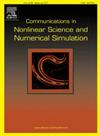One-way coupled Eulerian–Lagrangian strategy for wave propagation and impact on coastal areas
IF 3.4
2区 数学
Q1 MATHEMATICS, APPLIED
Communications in Nonlinear Science and Numerical Simulation
Pub Date : 2025-04-16
DOI:10.1016/j.cnsns.2025.108845
引用次数: 0
Abstract
Coastal hazards have gained importance in recent years due to the increasing number of extreme phenomena induced by climate change. The numerical simulation of such events represents a considerable challenge, due to the high non-linearity of the problem, the broadness of the domain, and the diversity of the involved scales. Holistic three-dimensional simulations of the whole domain are typically too computationally demanding and may not be necessary for the wave propagation analysis, where reduced models based on shallow-water hypotheses can be employed. However, these simplified approaches fail when modeling the intricate impact phenomena that occur in coastal zones. To reduce the computational cost without losing accuracy, we propose a one-way coupled approach using a Shallow-Water Eulerian solver to model wave propagation in the far field, and a complete three-dimensional Navier–Stokes Lagrangian strategy to simulate the wave impacting the coastal areas. A computational interface is used to store the kinematic information during the far-field analysis and to transfer it as an inlet condition to the near-field solver. The accuracy, efficiency and robustness of the proposed approach are shown in both 2D and 3D by studying two experimental tests.
波浪传播及其对沿海地区影响的单向耦合欧拉-拉格朗日策略
近年来,由于气候变化引起的极端现象越来越多,沿海灾害变得越来越重要。由于问题的高度非线性、领域的广泛性和涉及尺度的多样性,这类事件的数值模拟是一个相当大的挑战。整个区域的整体三维模拟通常对计算要求太高,对于波传播分析可能没有必要,在这种情况下可以采用基于浅水假设的简化模型。然而,这些简化的方法在模拟沿海地区发生的复杂撞击现象时失败了。为了在不损失精度的前提下降低计算成本,我们提出了一种使用浅水欧拉求解器模拟远场波浪传播的单向耦合方法,以及一种完整的三维纳维-斯托克斯拉格朗日策略来模拟波浪对沿海地区的影响。计算接口用于存储远场分析过程中的运动学信息,并将其作为入口条件传递给近场求解器。通过两组实验验证了该方法在二维和三维环境下的准确性、高效性和鲁棒性。
本文章由计算机程序翻译,如有差异,请以英文原文为准。
求助全文
约1分钟内获得全文
求助全文
来源期刊

Communications in Nonlinear Science and Numerical Simulation
MATHEMATICS, APPLIED-MATHEMATICS, INTERDISCIPLINARY APPLICATIONS
CiteScore
6.80
自引率
7.70%
发文量
378
审稿时长
78 days
期刊介绍:
The journal publishes original research findings on experimental observation, mathematical modeling, theoretical analysis and numerical simulation, for more accurate description, better prediction or novel application, of nonlinear phenomena in science and engineering. It offers a venue for researchers to make rapid exchange of ideas and techniques in nonlinear science and complexity.
The submission of manuscripts with cross-disciplinary approaches in nonlinear science and complexity is particularly encouraged.
Topics of interest:
Nonlinear differential or delay equations, Lie group analysis and asymptotic methods, Discontinuous systems, Fractals, Fractional calculus and dynamics, Nonlinear effects in quantum mechanics, Nonlinear stochastic processes, Experimental nonlinear science, Time-series and signal analysis, Computational methods and simulations in nonlinear science and engineering, Control of dynamical systems, Synchronization, Lyapunov analysis, High-dimensional chaos and turbulence, Chaos in Hamiltonian systems, Integrable systems and solitons, Collective behavior in many-body systems, Biological physics and networks, Nonlinear mechanical systems, Complex systems and complexity.
No length limitation for contributions is set, but only concisely written manuscripts are published. Brief papers are published on the basis of Rapid Communications. Discussions of previously published papers are welcome.
 求助内容:
求助内容: 应助结果提醒方式:
应助结果提醒方式:


